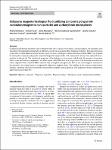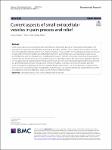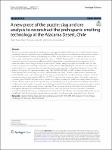Search
Author
- Manyk, T. (3)
- Murawski, K. (3)
- Baumgartner, Jörg (2)
- Guizani, Chamseddine (2)
- next >
Subject
Date issued
- 2023 (187)
Has File(s)
- true (187)
Search Results
Conductive polypyrrole nanotubes were synthesized with a two-step one-pot synthesis. During synthesis, the nanotubes were decorated with magnetite nanoparticles at different concentrations granting them magnetic properties. The characterization of the tubes revealed differences from the theoretical reactions. A bidisperse magnetorheological fluid (MRF) was prepared by mixing the composite polypyrrole nanotubes/magnetite nanoparticles with commercial carbonyl iron spherical microparticles in silicone oil. The rheological properties of the bidisperse system were studied under the presence of magnetic field at room and elevated temperature. |
Glass-ceramic nanocrystals (GCNs) were created via annealing at crystallization temperature Tc for the parent BaTiO3-V2O5-PbO glasses prepared by the melt quenching technique. The amorphous character of the existing quenched glasses was confirmed by scanning electron microscopy. Furthermore, the general characteristics of x-ray diffraction support the amorphous nature of the glasses. In the related heat-treated samples, the typical nanostructure size is less than 60 nm. It was discovered that an increase in the density of the GCNs occurred with an increase in the BaTiO3 percentage. Also, with increasing BaTiO3 content, a slight increase was observed in the crystallization and glass transition temperature from 335°C to 365°C and 265°C to 320°C, respectively. |
Experimental fatigue tests with variable amplitude (VA) load were conducted for notched uncoated and hot-dip galvanized (HDG) notched laser cut components made of S960 ultra-high-strength steel (UHSS). Tests were conducted with low (constant minimum) and high (constant maximum) mean stresses and major differences between fatigue lives with the tests on identical equivalent stress were found. A multiparametric 4R method application, in conjunction with the theory of critical distances (TCD) to obtain fatigue-effective stresses at notch, was utilized on the mean stress correction and fatigue strength assessment. The introduced 4R method was proven to be highly efficient to consider different mean stress levels based on the experimental results and different loading and specimen types ... |
Human induced pluripotent stem cell-derived cardiomyocytes (hiPSC-CMs) gain attention as a potent cell source in regenerative medicine and drug discovery. With the necessity of the demands for experimental models to create a more physiologically relevant model of the heart in vitro we herein investigate a 3D culturing platform and a method for assessing rhythm in hiPSC-CMs. |
S500MC steel is a grade of high-strength low-alloy steel (HSLA) which is widely used in the automotive industry and for agricultural machinery and equipment. Considering properties of this alloy, selection of the welding process and parameters becomes essential to ensure that HSLA assemblies meet specific service requirements. In this work, mechanical and metallurgical properties of S500MC steel produced by autogenous laser beam welding (LBW) and automatic gas tungsten arc welding (GTAW) were compared. Tensile testing, metallography, hardness testing, and fractographic analysis were performed on the welded specimens, revealing that the heat input by these welding processes caused significant microstructural changes within the joints. In LBW samples, the heat input about 10 times low... |
This work focuses on the investigation of the corrosion inhibition of heat-treated EN8 steel in the presence of sodium salt of dodecyl benzene sulfonic acid in 0.5 M H2SO4 using the Gravimetric and Electrochemical methods. Austenitizing is performed at 700, 750, 790, and 900 °C for 2 h followed by quenching in water. When the heat-treated metal is exposed to 0.5 M H2SO4 at the temperature of 30, 40, 50, and 60 °C in the presence of dodecyl benzene sulfonic acid sodium salt inhibitor, the corrosion inhibition increased with different heat treatment conditions depending on the phase change. This work investigates the activation and adsorption isotherm parameters. The adsorption isotherms were used to estimate Gibb's free energy change. The inhibition efficiency increased with inhibito... |
Medieval paper, a handmade product, is made with a mould which leaves an indelible imprint on the sheet of paper. This imprint includes chain lines, laid lines and watermarks which are often visible on the sheet. Extracting these features allows the identification of the paper stock and gives information about the chronology, localisation and movement of manuscripts and people. Most computational work for feature extraction of paper analysis has so far focused on radiography or transmitted light images. While these imaging methods provide clear visualisation of the features of interest, they are expensive and time consuming in their acquisition and not feasible for smaller institutions. However, reflected light images of medieval paper manuscripts are abundant and possibly cheaper i... |
Effect of Undercooling on the Microstructure and Mechanical Properties of Hyper-eutectic Ni–Sn Alloy In this study, container-less solidification of hyper-eutectic Ni–Sn alloy has been performed by using the electromagnetic levitation technique. The effect of undercooling on the formed microstructure and on the mechanical properties have been investigated. Growth velocities were determined by high-speed video-imaging of the solidification process. A step change in the growth velocities that are increasing with increasing undercooling is observed. This aligns with an observed first change in the microstructure between low and intermediate undercoolings. At the lower undercoolings, a pro-eutectic Ni3Sn phase along with lamellar eutectic structure in the inter-dendritic region is found. At intermediate undercooling of 100–150 K, a divorced eutectic microstructure is observed whereas a... |
Small extracellular vesicles (sEVs) have been identified as a noteworthy paracrine mechanism of intercellular communication in diagnosing and managing neurological disorders. Current research suggests that sEVs play a pivotal role in the pathological progression of pain, emphasizing their critical function in the pathological progression of pain in acute and chronic pain models. By facilitating the transfer of diverse molecules, such as proteins, nucleic acids, and metabolites, sEVs can modulate pain signaling transmission in both the central and peripheral nervous systems. Furthermore, the unique molecules conveyed by sEVs in pain disorders indicate their potential as diagnostic biomarkers. The application of sEVs derived from mesenchymal stem cells (MSCs) in regenerative pain medi... |
The Incas appropriated many local metallurgical technologies throughout the Andes, each of which had its unique peculiarities and was based on local ancestral knowledge. The widespread use of tin-bronze during the Inca expansion, the development of mining and smelting sites, as well as ethno-historical records evidence the Incas’ interest in copper smelting, a key activity in the Andes since ca. 1400 BC. However, little is known about the technical parameters achieved by ancient metallurgists and the changes that occurred during the Inca expansion. In this paper, we address these changes through a case study of Copiapó valley, focusing on the Viña del Cerro site, one of the most famous Inca smelting centres of the southern Andes. Although this place was architectonically restructure... |










